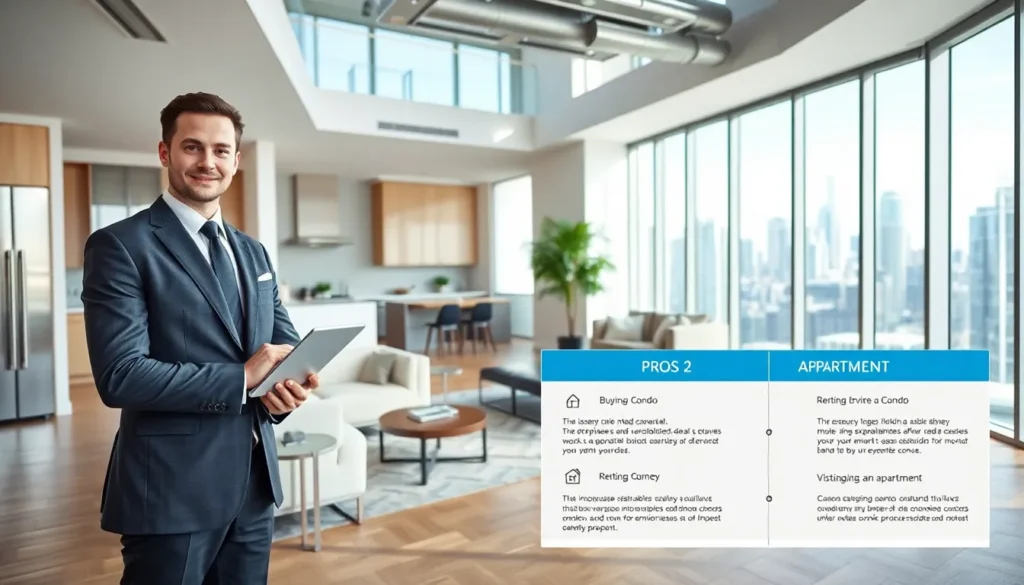Table of Contents
ToggleRenting for the first time can feel like stepping into a high-stakes game of chess, intimidating, slightly confusing, and a little bit exciting. Don’t worry, that’s perfectly normal. From deciphering the mysterious language of rental agreements to finding the perfect apartment that feels like home, it’s a journey many have undertaken and emerged wiser. Imagine navigating this new adventure with confidence and savvy. This guide is about to arm you with the essential tips you need to thrive in the rental market. Buckle up: you’re about to find out how to rent like a pro.
Understanding the Rental Market

The rental market can be a bit like a roller coaster, full of ups, downs, and plenty of unexpected twists. Understanding its dynamics is crucial for first-time renters.
- Regional Differences: Rental prices vary significantly depending on location. Urban areas typically have higher rents compared to suburban or rural settings. It’s essential to research the area where you wish to live. Learn about local trends and consider seasonal fluctuations: renting in winter might provide better deals compared to the bustling summer months.
- Supply and Demand: When demand for rental properties exceeds supply, prices increase. Similarly, in a landlord’s market, you may find fewer options at a higher cost. Stay informed about developments in your desired location to avoid surprises.
- Types of Rentals: Understand the different types of rentals available. You might choose between apartments, condos, or houses. Each type comes with its perks, like amenities, space, or backyard access. Bearing this in mind can help narrow down your options.
Researching Rental Properties
Research is your best friend in the rental process. The internet is teeming with platforms showcasing available rentals. But, a little due diligence can amplify your chances of finding the perfect space.
- Online Resources: Websites like Zillow, Apartments.com, and Craigslist can kickstart your search. Filter by budget, size, and amenities to zero in on properties that pique your interest.
- Local Listings: Don’t underestimate local classifieds or community boards. Sometimes hidden gems appear here, offering lower rents or unique features you might not find elsewhere.
- Neighborhood Visits: It’s worth physically visiting neighborhoods you’re eyeing. Explore what it’s like to live there, check out grocery stores, parks, and public transport access. Talking to existing residents can also provide insight into the community vibe.
Preparing Your Finances
Getting financially prepared is like warming up before a marathon: essential for a smooth ride.
- Budgeting: Start by calculating what you can reasonably afford. The general rule is that your rent should not exceed 30% of your income. Factor in additional costs, such as utilities, internet, and renter’s insurance.
- Savings: It’s wise to have a financial cushion. Aim to save at least two months’ worth of rent before moving in. This buffer helps manage potential emergencies or unexpected repairs, ensuring you’re never caught off guard.
- Credit Score: A solid credit score can make renting easier and potentially cheaper. A good score might lead to lower deposits or better rental terms, so check yours and make adjustments if necessary before applying.
Navigating the Lease Agreement
The lease agreement is your roadmap to living in your new rental, so it’s crucial to navigate it carefully.
- Terms and Conditions: Pay attention to the lease duration, renewal terms, and termination clauses. Knowing these details can save you from unforeseen pitfalls down the line.
- Security Deposit: Typically, you will need to provide a security deposit. Understand the conditions under which you can get it back. Landlords usually require it to cover any potential damages.
- Rules and Restrictions: Be clear on rules about pets, subletting, and maintenance responsibilities. Clarifying these expectations upfront ensures a smoother landlord-tenant relationship.
Moving In: What to Expect
Your moving day can be both exhilarating and a bit chaotic. Here’s how to streamline the process.
- Utility Setup: Arrange for utilities like water, electricity, gas, and internet to be activated before you arrive. There’s nothing worse than moving into a dark, silent home.
- Inspection: Conduct a thorough walk-through with your landlord upon arrival. Note any existing damage, and ensure that everything is in working order. Give copies of the inspection record to your landlord to prevent any disputes when moving out.
- Secure Your Space: Consider changing locks, especially if it’s a multi-tenant building. Your safety and peace of mind should always be a priority.
Maintaining a Positive Relationship with Your Landlord
Fostering a good relationship with your landlord can significantly enhance your renting experience.
- Open Communication: Be upfront about any maintenance issues. Promptly report leaks, appliance failures, or safety concerns. Your landlord will appreciate your communication, and timely issues can often lead to quicker repairs.
- Respect the Property: Treat the rental as your home. This means keeping shared spaces clean and respecting noise levels. A respectful tenant often enjoys a smoother relationship with their landlord.
- Flexibility: Life can throw curveballs. Being considerate about minor rule changes or negotiations can lead to a more amicable landlord-tenant dynamic.
A good tenant-landlord relationship is a two-way street, facilitating a pleasant renting experience.




